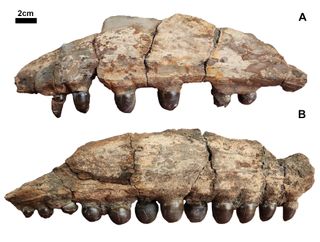Fossils from a large, unusual dinosaur with large globular teeth have been unearthed in Texas, a new study reveals.
Two adult jaw fragments provide insight into the lifestyle of Globidens alabamaensiswhich may have been up to 20 feet (6 meters) long. The dull teeth that sit in the jaws show the brutal power that the masasas bring to their victims.
“These mushroom-shaped structures are good for impact attacks – for breaking shells. If something comes out and you smash it, that’s kind of it,” Bethany Burke Franklinmarine paleontologist and professor at the Texas Through Time museum in Hillsboro, told Live Science. Franklin, who specializes in marine reptiles, was not involved in this study.
During the Late Cretaceous (100.5 to 66 million years ago), many marine predators such as dolphin-like ichthyosaurs and long-necked plesiosaurs succumbed to evolution while climate and subsequent changes in the marine environment. The mosasaurs became the main predators in the shallow seas of the time, taking over the places where they were once known. These reptiles diversified rapidly, filling many niches in an unstable and prey-rich environment.
G. alabamaensis it was discovered in 1912, but only a few specimens of this mosasaur have ever been excavated. Most of the fossil evidence consists of teeth and small parts of the jaw. Four more Globidens newly described species.
Related: ‘Closer than people think’: Woolly mammoth ‘de-extinction’ is closer to reality – and we don’t know what happens next
Although many mosasaurs boasted a terrifying array of knife-like teeth, Globidens they were dull, rounded teeth that were perfect for breaking the shells of turtles, ammonites and bivalves. The Western Interior Seaway, which divided what is now North America during the Late Cretaceous, would have provided G. alabamaensis which has a wide variety of prey.
The researchers described the discovery of two jaw bones in a paper published in Journal of Paleontological Sciences on Aug. 14

The fragments were discovered by a freelance fossil hunter in 2023 in the Ozan Formation in northeast Texas. The deposit they were found in is from the Campanian Period (83.6 million to 72.1 million years ago) and is only 8 inches (20 centimeters) thick. However it has proved rich in fossils, including some of the mosasaur.
Preserving even part of an animal’s head is exciting, Franklin said. “Cranial materials tend to be very damaged, especially in these thin cases,” he explained.
One jaw still holds 12 teeth; one left only six. The teeth are three inches long and rounded, well designed to break the hard shells of mollusks. In the other jaw, the wisdom tooth remains below the gum line. It would have appeared later to fill the gap. Scientists believe that, like sharks, mosasas shed their teeth and replace them throughout their lives.
Because of these unique teeth, they were able to coexist with other large lizards that hunted a variety of prey, Franklin said.
“The adaptation may have been influenced by the proliferation of cephalopods,” he explained. “Many types of living things could live together because they did not use the same resources [mosasaurs] they were some of the most rapidly evolving predators of the time. They filled the gaps left by other large sea predators – there were large pipes in the food web. “
#80millionyearold #sea #monsters #jaws #packed #giant #teeth #frenzy #crushing #prey #Texas